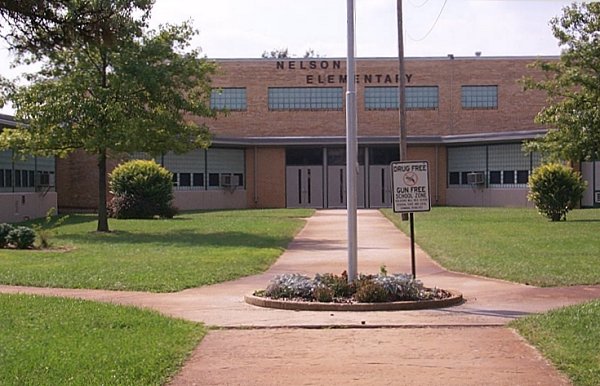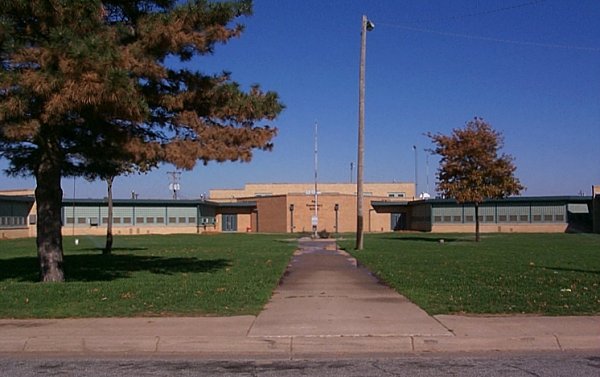A 1974 article from the local newspaper.
Little Red School House Started It All
Prefacing the growth of Haysville, the Little Red School House had its day. For nearly half a century before the establishment of Haysville as a city “The Little Red School House” was the popular meeting place of the day.
Known only as District 57, it marked the sum and substance of Haysville student’s education. Those who obtained higher learning went away to get their education with Wichita being the most accessible with high schools and University at their command.
For 16 years, Mrs. Mildred McCoin recorded the “learnin’s” of the pupils who attended the little brick school. The school absorbed Mayfield and Brunswick schools during her years as principal and instructor. The school is often referred to as the “Vreeland School.”
F.G. Stearns, Cliff Hurley, Eva (Baughman) Jackson and Delos Nelson are among the Haysville boosters who at one time attended the pioneer district school. Some of them date back to the time of the frame construction. David Edgar Wire Iii, was one such youth.
F. G. Stearns also had the privilege of being a member of the board for years along with Wilbur Hatcher, Carl Cooper and the late L.A. Nelson who have been predominant in advancing Haysville’s growth continuously through the years.
Initiation of the school buildings in Haysville proper was marked by the construction of the west wing of Hemphill constructed during 1947-48. The school was built after a bond issue for $68,000 was approved by the voters.
In its original structure, the west wing had four classrooms, a cafeteria and all-purpose room. The building was converted to serve as administration building later and housed the superintendent of schools, guidance counselor, curriculum coordinator’s office and the business administration office. The building also housed the curriculum library where the supplementary teaching aides are maintained and supplies are stored.
With the completion of the east wing at Hemphill, provisions were made for eight classrooms, offices for the principal, secretary and janitor’s workroom were maintained. A bond issued of $109,000 was launched successfully in May 1951, to complement the added structure.
Before the east wing at Hemphill was completed a bus barn was added to the complement of buildings at a cost of $11,328. Before it was ever used for its designated purpose the need for additional classroom space was so urgent the area was divided into classrooms and used for that purpose until 1962.
A covered walk provides access to the east wing from the administration building and to the bus barns, (classroom space) and storage facilities for the janitorial supplies and workshop for the maintenance department.
Eight houses were purchased to be used for temporary classrooms until Nelson School was erected and dedicated to service.
Nelson School bonds in amount of $356,912.04 was approved and the school building was constructed in 1954-55. An addition was made to Nelson School in 19565 adding 12 classrooms at a cost of $106,279.92. Facilities of Nelson School were complemented with the dining room at a cost of $35,825.89. Nelson building boasts of 36 classrooms, a kitchen, dining room, a gym-auditorium combination and a library.
In the years 1955-56 bonds were issued in the amount of $50,000 to purchase additional land for more school buildings. The present site of Rex and the Junior High School building was purchased. In February of 1957 a bond was approved for the construction of Rex School. Rex building cost $501,410 and with 36 classrooms, kitchen, gym-auditorium combination and library houses 37 teachers and accommodates nearly 1,000 students.
Federal funds abetted the erection of both Rex and the Junior High School under application through the Public Law 815 specifications.
A bond issue totaling $850,000 in July 1960 was approved for the construction of the Junior High building which was completed in February 1962. The building was erected at a total cost of $744,333 with the balance of the approved bond being used for sewer hookup, soil analysis and the provision of new furniture to complement the new structure. Haysville Junior High was 34 classrooms, supervised by 33 teachers and Principal Wilbur Humphries. There is a library, gym-auditorium, cafeteria, home economic room, industrial arts room, language laboratory, three science rooms and office space.
Campus High was built in 1959 and employed to serve the area with the September term of 1960.
From the Little Red School House in 1950, Haysville has acquired a fine complement of schools with the best of administrative leaders at their helm. It has a faculty second to none making it an ideal location for the industrial worker or man seeking to promote any enterprising establishment.
The educational complement is financed through ad valorem property tax, dog tax, sale of capital items and other means of local command. Also from the county apportionment’s, fines and forfeitures: state annual school fund and payments for special education, state emergency fund, resident sales tax; payments under NDEA act and textbook rental fund; and federal support is obtained under Public Law 7\874.
Freeman School was built at the same time as the current bus barn and administrative office building on an 89-acre tract of land near W. Grand and Meridian.
The cornerstone on the Freeman Building was laid in 1960, but the building was not occupied until 1966.
Freeman has 23 classrooms, a cafeteria and offices for school staff members. The building has been vacant for a brief period of time since 1966, and today Freeman is closed.
At the end of the 1972-73 school year there was an enrollment of 396 at Freeman School. When the school opened its doors in 1966 there was in excess of 600 students.
Decline in enrollment in the school district prompted officials to close the doors of Freeman School in 19763. The building was used for a month in the winter of 1974 while Rex School was undergoing repairs on a leaking gasline.
The bus barn can handle parking for 22 buses. The central supply office and maintenance equipment are housed in the bus barn.
The USD 261 administrative center houses most of the office relating to business, administration and special services for the district. The building houses a meeting place for the board of education.
The administrative center houses a computer center in its east wing. The school district’s business, payroll, budget, and student grades are computed at the center.
The computer center contracts for student grading in the Derby School District and computes the payroll for Kansas Newman College.
The 80-acre tract of land is equipped with a football field, three ball diamonds and a playground. The Peach Capital Rodeo Grounds are set up on the school property near Freeman School. The Peach Capital Rodeo is held on the grounds each year on the first weekend in August.






Recent Comments